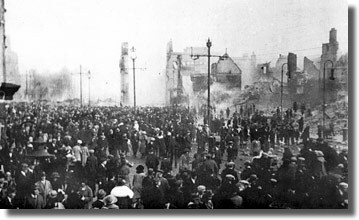|
Burning of Cork City by British Forces (Irish War of Independence - First Cork Brigade) |
|
Citizens of Cork view the devastated city centre on the morning following the great fire. |
|
Some time after the ambush a large group of Black and Tans opened fire without the slightest warning or provocation near the corner of King Street (now MacCurtain Street) and Summerhill North. The shooting was totally indiscriminate. Women and children huddled in doorways or ran for shelter. The streets soon became deserted. Some panic-stricken people took refuge at the railway station, and could hear rifle and revolver fire continue for more than twenty minutes. However, the worst was yet to come. At 10 pm. Alfred J. Huston, the Superintendent of the Cork city fire brigade, ordered the ambulance from Grattan Street fire station to Dillon's Cross in case there were casualties from a fire which was raging. (A number of houses in the vacinity of Dillon's Cross had been set alight by irate British forces). As the ambulance was travelling through Patrick Street the firemen came upon a fire at Grant and Co., a department store at the southern end of Patrick Street. The driver of the ambulance described an encounter they then had - "On reaching the comer of Patrick Street, I, who was driving, saw forty or fifty men walking in a body in the centre of Patrick Street, coming towards us in very mixed dress - some with khaki coats, some with khaki trousers, and some wore glengarry caps". At 10.30 pm Captain Huston received a report of the fire in Grant's. He found that 'the fire had gained considerable headway and the flames were coming through the roof'. The fire brigade was successful in containing this fire. If it had spread to the English Market, which was located to the rear of Grant's, a major conflagration could have occurred. While the fire in Grant's was being fought, Captain Huston received word from the town clerk that the Munster Arcade and Cash's department store were on fire. It was now about 11.30p.m. These two buildings were situated on the eastern side of Patrick Street. All available units of the fire brigade were immediately sent to fight these fires, which were spreading rapidly. Despite the best efforts of the fire brigade, the fires spread to adjoining buildings and caused extensive damage. The blaze in the Munster Arcade spread to the following establishments - Egan's Jewellers, Sunner's, Forrest's, the Dartry Dye Co., Saxone Shoe Co., Burton's Tailors, Thompson's and Cudmore's. The fire from Cash's spread to the Lee Cinema, Roche's Stores, Lee Boot Co., Connell & Co., Scully's, Wolfe's and O'Sullivan's. All of these buildings were totally destroyed. Shortly before dawn, two of Cork city's historic buildings would also be destroyed by flames. On Sunday 12 December Captain Huston received word that both City Hall and the nearby Carnegie Library had been put to the torch. Seven members of the fire brigade tried in vain to fight the flames and, like the buildings in Patrick Street, both places were completely destroyed. As they fought the flames the members of the fire brigade were subject to continuous harassment from crown forces, who fired on them, turned off hydrants and slashed hoses with their bayonets. In his report to the Lord Mayor, Captain Huston wrote; "I have no hesitation in stating I believe all the above fires were incendiary fires and that a considerable amount of petrol or some such inflammable spirit was used in one and all of them. In some cases explosives were also used and persons were seen to go into and come out of the structures after breaking an entrance into same, and in some cases I have attended the people have been brought out of their houses and detained in by-lanes until the fire gained great headway". Widespread looting also occurred throughout the night.
A young girl who lived at Clankittane, near Victoria Barracks, recalled
seeing a lorry-load of Auxiliaries returning to the barracks in the early
hours of Sunday, December 12th. The lorry, which was full of stolen goods,
stopped outside Hennessy's public house. Some drunken Auxiliaries dismounted
and banged on the door of the pub, shouting for the owner. When someone put
their head out of an upstairs window, an Auxiliary made a threatening
gesture with a revolver and demanded that the doors be opened and drink
served. (1) Three arrests were made. F.
R. Eastwood, Writing about the burning of Cork, Florence O'Donoghue, intelligence officer of Cork No. 1 Brigade at the time of the atrocity, stated; "It is difficult to say with certainty whether or not Cork would have been burned on that night if there had not been an ambush at Dillon's Cross. What appears more probable is that the ambush provided the excuse for an act which was long premeditated and for which all arrangements had been made. The rapidity with which the supplies of petrol and Verey lights were brought from Cork barracks to the centre of the city, and the deliberate manner in which the work of firing the premises was divided amongst groups under the control of officers, gives evidence of organisation and pre-arrangement. Moreover, the selection of certain premises for destruction and the attempt made by an Auxiliary officer to prevent the looting of one shop by Black and Tans: 'You are in the wrong shop; that man is a Loyalist,' and the reply, 'We don't give a damn; this is the shop that was pointed out to us', is additional proof that the matter had been carefully planned beforehand". The action of the British
security forces in Cork on the night of 11/12 December brought widespread
condemnation upon the officers and men who garrisoned Victoria Barracks.
Whatever remaining goodwill the citizens of Cork may have had for the
British forces was now gone.
Map of Cork city centre detailing areas damaged and destroyed
|
|
|
